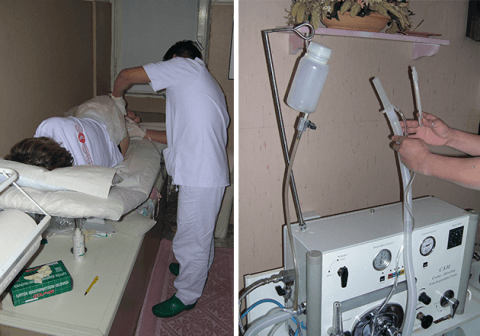
Colon Hydrotherapy
Intestinal cleansing is the main feature of a complementary medical treatment called “Colon Hydrotherapy, Colonic Irrigation, Color Cleansing, Colon Wash or, more simply, Colonic“, whose purpose is to restore the normal and correct functions of the colon. Colon hydrotherapy is particularly widespread in some Anglo-Saxon countries, especially in Germany, Britain and the United States. Its most important element is the cleansing of the colon, but this is only part of the treatment.
The first stage consists of an accurate diagnosis: Cleansing of the colon should be preceded by a consultation in which the following are evaluated: bowel function, intestinal motility and the ability to absorb nutrients; typical symptoms such as pain and abdominal distension, bloating and blood loss; and pre-existing diseases such as inflammatory bowel disease (ulcerative colitis, Crohn’s disease), colon cancer and anorectal diseases (haemorrhoids, fissures, fistulae, abscesses, prolapse, etc.).
Then follows a preparatory phase, which varies in time from a few days to a week, during which the patient takes preparations to ensure the faeces will be soft when the cleansing takes place; substances are also administered to repopulate the colon after it has been cleansed. Cleansing is the most import element of colon hydrotherapy; it eliminates all faecal matter from the colon along with the pathogenic bacteria and toxic material. Its effectiveness is closely linked to the experience and skills of those performing it as well as to the performance of the apparatus and instrumentation.
The cycle ends with post-treatment, during which intestinal repopulation occurs via the administration of appropriate lactic ferments (eubiotics and probiotics), in addition to vitamins and mineral trace elements. Colon hydrotherapy can be practised at any age, from infancy to old age.
How it is performed
The treatment is performed in a room specially dedicated to this purpose, preferably equipped with health services. The hydrocolontherapy equipment is connected to the hydraulic piping of the aqueduct, but after a path through special filters, the water that is immersed in the colon has been cleansed with particles up to 5 microns and microelements. The machine also contains:
- a thermometer that does not allow the water to exceed 40 ° C
- a water mixer for temperature control
- a stainless steel valve for flow control, so that drain water can not be recirculated.
- a pressure gauge with a safety valve connected to an external pressure indicator
- an automatic system for disinfecting and cleaning the appliance.
- a series of filters to purify water from limestone and other minerals.
In order to be marketed, the equipment must have passed the prescribed controls and display the EC Authorization Mark.

The patient lies on a bed close to the apparatus; initially they are on their left side so that a suitable two-way speculum can be inserted. There is a smaller tube for carrying the filtered water from the cleansing apparatus to the patient and a larger one, also connected to the cleansing apparatus, for disposing of the waste water from the patient’s colon. These tubes are transparent, to allow inspection by the therapist during cleansing.
After the speculum has been inserted, the patient is asked to lie on their back with their knees slightly bent. During the insertion of the speculum, and throughout the entire cleansing process, the patient is covered with a large sheet or a special gown.
The therapist sets the temperature and the cleansing pressure on the instruments and allows the water to flow through the rectum and along the full length of the colon. The patient is temporarily filled with a fixed volume of water up to the set tolerance limit. This induces the creation of peristaltic waves with consequent contractions of the colon, and the patient begins to expel the faecal matter through the discharge tube. The filling operation, and the subsequent removal of the dissolved faecal matter, is repeated an appropriate number of times until the water comes out completely clean. If the pre-cleansing was properly carried out, i.e. the faeces were properly prepared during the week before cleansing, and there is good bowel tone, the repeated cycles will efficiently empty the bowel; the patient will experience no pain or discomfort.

The cleansing equipment is a closed circuit so there are no noticeable unpleasant odours in the treatment room. The cleansing is often accompanied by gentle massage of the abdominal wall which follows the direction of the water: anti-clockwise during the filling phase and clockwise during emptying. Plantar reflexology may be useful during colon hydrotherapy both for its effect on intestinal emptying and for its general benefits.
The therapist will often assist intestinal emptying with appropriate abdominal massage using circular and centrifugal movements.
The cleansing equipment is a closed circuit so there are no noticeable unpleasant odours in the treatment room. The cleansing is often accompanied by gentle massage of the abdominal wall which follows the direction of the water: anti-clockwise during the filling phase and clockwise during emptying. Plantar reflexology may be useful during colon hydrotherapy both for its effect on intestinal emptying and for its general benefits.
Each session lasts about 45-50 minutes. After the treatment, the patient is asked to remain in the treatment room for a few minutes (if it is equipped with toilet facilities) or in the adjoining bathroom, in case there are any further evacuations of residual matter from the upper portions of the colon. These will thus be eliminated before leaving the practice.



